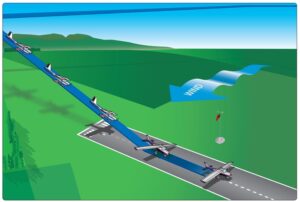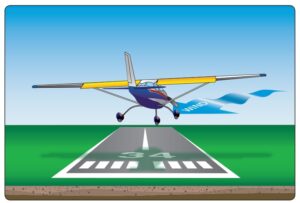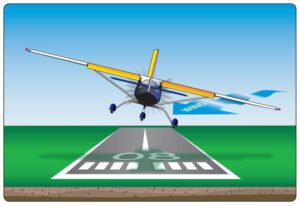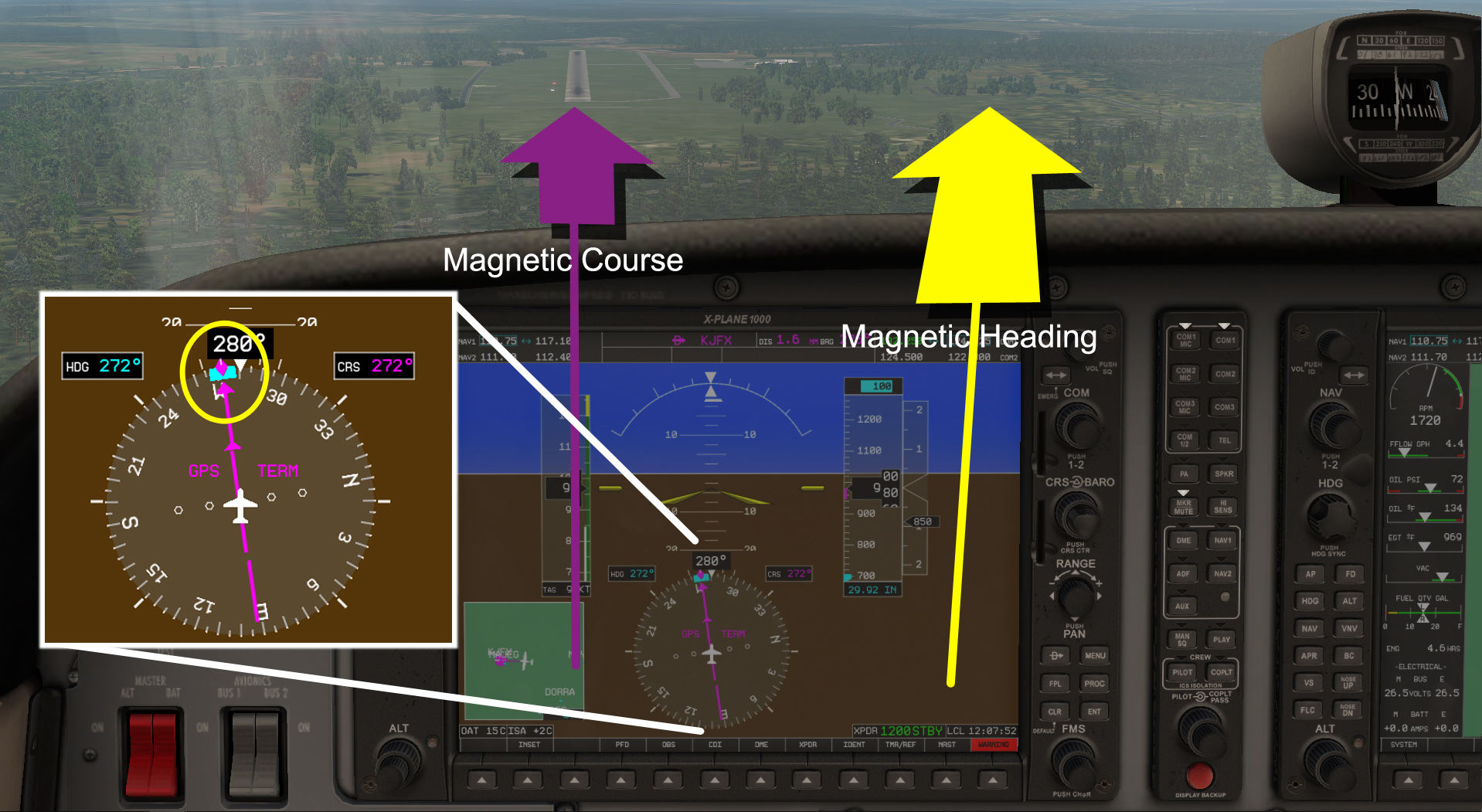 As pilots, we often experience an approach to landing with winds that are not directly aligned with the runway. Any time a crosswind condition exists, control inputs are required to ensure that the airplane’s flight path remains in line with the extended runway centerline. Without these control inputs and corrections, the airplane will be side-loaded (more on that later) and could potentially roll over, putting the pilot, passengers, and others in danger.
As pilots, we often experience an approach to landing with winds that are not directly aligned with the runway. Any time a crosswind condition exists, control inputs are required to ensure that the airplane’s flight path remains in line with the extended runway centerline. Without these control inputs and corrections, the airplane will be side-loaded (more on that later) and could potentially roll over, putting the pilot, passengers, and others in danger.
This article explains the hazards of not properly aligning the airplane with the runway, describes two common methods of correcting for crosswinds, and lists the common errors associated with failure to properly fly a crosswind approach and landing.
Dangers Of Not Lining The Airplane Up With The Runway Centerline
It is crucial for pilots to understand the dangers associated with touching down an airplane crabbed at an angle and why it should always be avoided.
One danger is the potential to side-load the landing gears. In non-crosswind conditions, the main landing gear should be parallel to the runway centerline so that when the wheels touch the runway, they begin to spin smoothly and allow the aircraft to roll down the runway to a stop. When the wheels are not aligned to the centerline, they are unable to spin smoothly because the runway is in contact with the sides of the tires instead of direct contact with the face of the tread. Instead of smoothly rolling, the airplane may drift or skip on its side, attempting to get on the ground–much like when a person trips on a rock. This is called “side-loading” and can cause serious damage to the tires and landing gear components.
In extreme cases, side-loading can lead a tricycle gear airplane to uncontrollably tip on its side and roll over. It can also cause the wingtip to graze the ground, resulting in significant damage to the structure of the airplane and its fuel tanks. When that happens in a tricycle gear airplane, the nose of the plane will come into contact with the ground, damaging the propeller and engine. These damages are expensive to repair and, in more severe cases, can make the airplane unairworthy. More importantly, these situations put the lives of the pilot(s), any passengers, and others in the vicinity in grave danger.
 Crosswind Correction Method 1: The Crab Method
Crosswind Correction Method 1: The Crab Method
With the crab method, the heading of the aircraft is different than the ground track. This method configures the airplane to “crab,” which essentially means the plane will fly sideways as viewed from the ground. The nose of the plane will be facing into the wind, while the flight path will remain over the extended runway centerline.
In an airplane with traditional analog steam gauges, focus your attention outside. Continually look outside and focus on the runway (while crosschecking that your airspeed, altitude, and descent rate are acceptable). If the runway looks like it is offset, your correction angle needs adjusted. The main goal is to ensure that the runway appears straight and the flight path is in line with the extended runway centerline. To help you develop more precision, practice ground reference maneuvers, such as rectangular course, turns around a point, and s-turns.
When flying an instrument approach using advanced avionics such as a Garmin G1000, you should “fly the diamond” down to the runway. The magenta diamond represents your magnetic course (flight path). Set the approach course with the heading bug and the CDI. Then, as long as the diamond remains directly over the heading bug, you will have the proper amount of crab angle. The system accounts for the winds acting on the aircraft and displays the required wind correction angle on the screen. When you fly the diamond, the nose of the airplane will be pointing away from the runway, but this allows the airplane to overcome the wind that is attempting to blow it off course. This can be practiced in a simulator, as shown below.
As you transition from approach to touchdown, align the nose of the aircraft with the runway by smoothly applying aileron into the wind and opposite rudder. In the example depicted above, the wind is from the right, so right aileron and left rudder input is required. Students often find it odd that the airplane is tilted in a shallow bank for landing, but this is exactly how the aircraft should be set up. The bank angle will allow the airplane to counter the wind attempting to blow it off the runway. By adding the rudder, the airplane’s nose will begin to yaw toward the runway and straighten out. When executed properly, the aircraft will then counteract the angled wind and fly straight down the runway.
Ailerons should be deflected into the wind. In the example above, this is to the right. The rudder should be deflected opposite the ailerons (to the left). Touch down on the upwind main gear first (right main gear in this scenario), followed by the downwind main gear (left main gear in this scenario), and finally the nose. Once you’ve landed, gradually increase the aileron inputs to their limits as the airplane slows down. This is an important step because the wind will still continue to act on the aircraft on the ground; the aileron input prevents the upwind wing from being lifted and the aircraft from “weathervaning” into the wind.
 Crosswind Correction Method 2: The Sideslip Method
Crosswind Correction Method 2: The Sideslip Method
The sideslip method essentially carries out the last transition phase of the crab method throughout the final approach. If the wind is coming from the right, deflect the ailerons to the right (into the wind) and apply opposite rudder to the left. Unlike the crab method, this technique allows the nose of the aircraft to be lined up with the runway throughout the final approach. There is no difference in runway heading and magnetic heading. The only difference is that the aircraft will be banked slightly toward the wind (right in this scenario). When the crosswind weakens on approach, adjust the aileron and rudder inputs to maintain the flight path over the extended runway centerline. If excessive control inputs are required, the crosswind condition at the intended airport of landing is too strong. Exercise caution and circle to return for landing, or land on a different runway or airport altogether where the wind more favorably aligns with the runway.
Be aware that as the airplane begins to slow down, the effectiveness of the crosswind corrections begins to weaken. Thus, as you fly closer to the runway, more input is required for the aileron and rudder to maintain the proper amount of drift correction.
Just like the crab method, keep the corrections applied during the round out and land on the upwind gear first, followed by the downwind landing gear, and finally the nose gear. Once the upwind gear touches the runway, the downwind gear and nose gear will slowly settle onto the runway due to the decrease of forward momentum. Ensure that the corrections are well-timed and executed smoothly to prevent any side-loading and putting the airplane in a dangerous condition.
Vulnerabilities Of Each Method
The crab method typically requires a more proficient and experienced pilot to be carried out successfully because a certain level of pilot finesse is required to realign the longitudinal axis of the aircraft to the runway and maintain that flight path to landing, all within the last 200 ft. or so of altitude before touchdown. Executing the maneuver with excessive controls and failing to time it right can easily cause the airplane to side-load and drift or roll over on the runway.
The sideslip method is more commonly used when a sudden shift in the airplane configuration is not desired before touchdown. However, there is one significant concern with the sideslip method that inexperienced pilots should be aware of: having the airplane in a configuration where the ailerons and rudder are cross-controlled makes the airplane uncoordinated. An uncoordinated airplane at a low speed close to the ground can quickly stall and enter a spin. It is impossible to recover from a spin during an approach with insufficient altitude and would result in a crash.
Common Errors When Carrying Out Crosswind Approaches And Landings
- Landing in crosswinds that exceed the airplane’s maximum demonstrated crosswind component
- Undershooting or overshooting the runway during base to final turn due to improper compensation for wind drift
- Overcorrecting, making the airplane unstable
- Excessive sink rate or a dangerously low approach airspeed due to inadequate compensation for increased drag in a sideslip
- Side-loading the aircraft and drifting on the runway
- Excessive airspeed on touchdown, causing the airplane to float
- Failing to increase control inputs once the airplane has touched down
- Excessive braking
- Loss of aircraft control
If you would like to learn more about crosswind approach and landing, the instructors at Gleim recommend that you pick up a copy of the Gleim Private Pilot Flight Maneuvers and Practical Test Prep book. This book discusses each element of the Airman Certification Standards, including the knowledge, risk management, skills, and common errors for each area of operation applicable to private pilot certification. You should also consider flying these procedures in a flight simulator or with a CFI.
Written by Ryan Jeff, Aviation Research Assistant


